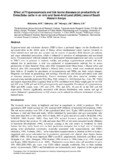| dc.contributor.author | Maichomo, M W | |
| dc.contributor.author | Gathuma, J M | |
| dc.contributor.author | Ndung'u, J M | |
| dc.contributor.author | Matere, C N | |
| dc.date.accessioned | 2013-06-13T12:56:15Z | |
| dc.date.available | 2013-06-13T12:56:15Z | |
| dc.date.issued | 2008 | |
| dc.identifier.citation | Maichomo, M.W.; Gathuma, J.M.; Ndungu, J.M.; Matere, C.N. 2006. Effect of trypanosomosis and tick borne diseases on productivity of Orma / Zebu cattle in an (ASAL) area of south western Kenya. IN: ISVEE 11: Proceedings of the 11th Symposium of the International Society for Veterinary Epidemiology and Economics, Cairns, Australia, Theme 2 - Disease distribution & determinants: Ruminants session. p. 741. Cairns (Australia): International Symposia for Veterinary Epidemiology and Economics (ISVEE). | en |
| dc.identifier.uri | http://www.sciquest.org.nz/node/64328 | |
| dc.identifier.uri | http://hdl.handle.net/11295/33159 | |
| dc.description | Conference paper | en |
| dc.description.abstract | Trypanosomosis and tick-borne diseases (TBD’s) have a profound impact on the livelihoods of
agro-pastoralists in the ASAL areas of Kenya whose transhumance nature exposes livestock to
tsetse-infested areas and also new ground may be sources of parasites. Both diseases are endemic
and cause suboptimal production, which is enhanced in presence of endoparasites and nutritional
stress. Trypanosomosis infected animals have pronounced immunosuppression and easily succumb
to TBD’s even in presence of endemic stability and perhaps trypanotolerant animals will show
minimal loss in production. A trial was conducted in trypanosomosis endemic foci to assess
productivity of three hundred Orma zebu (OZ) (trypanotolerant Orma boran x Maasai zebu) and
Sahiwal zebu (SZ) (susceptible Sahiwal x Maasai zebu) crosses, which were monitored monthly
from birth to 18 months for prevalence of trypanosomosis and TBDs, and body weight changes.
Diagnosis was based on parasitology and serology. Growth rate and disease prevalence were used
as outcome measures of productivity. Factors associated with these outcome variables were
assessed using multiple regression [Proc Reg, SAS version 9.1, SAS Institute Inc., Cary, NC, USA]
and logistic regression [Proc Logistic] fitted at 95% confidence level. Daily weight gain for the O/Z
and S/Z were 0.209 g/d and 0.212 g/d respectively and comparable. Prevalence of trypanosomosis,
TBD and EPG counts were 1.9% and 2.5%; 59% and 62%; 48 and 42 in the O/Z and S/Z
respectively. Factors significantly associated with disease distribution were season and age of
calves. Enhanced trypanotolerance in O/Z crosses can be utilized for effective reclamation of tsetseinfested
lands. | en |
| dc.language.iso | en | en |
| dc.subject | Trypanosomosis | en |
| dc.subject | Tick borne diseases | en |
| dc.subject | Productivity | en |
| dc.subject | Orma/Zebu cattle | en |
| dc.subject | Orma/Zebu cattle | en |
| dc.subject | South Western Kenya | en |
| dc.title | Effect of trypanosomosis and tick borne diseases on productivity of Orma / Zebu cattle in an (ASAL) area of south western Kenya | en |
| dc.type | Article | en |
| local.publisher | Department of Public Health, pharmacology and Toxicology, University of Nairobi | en |

